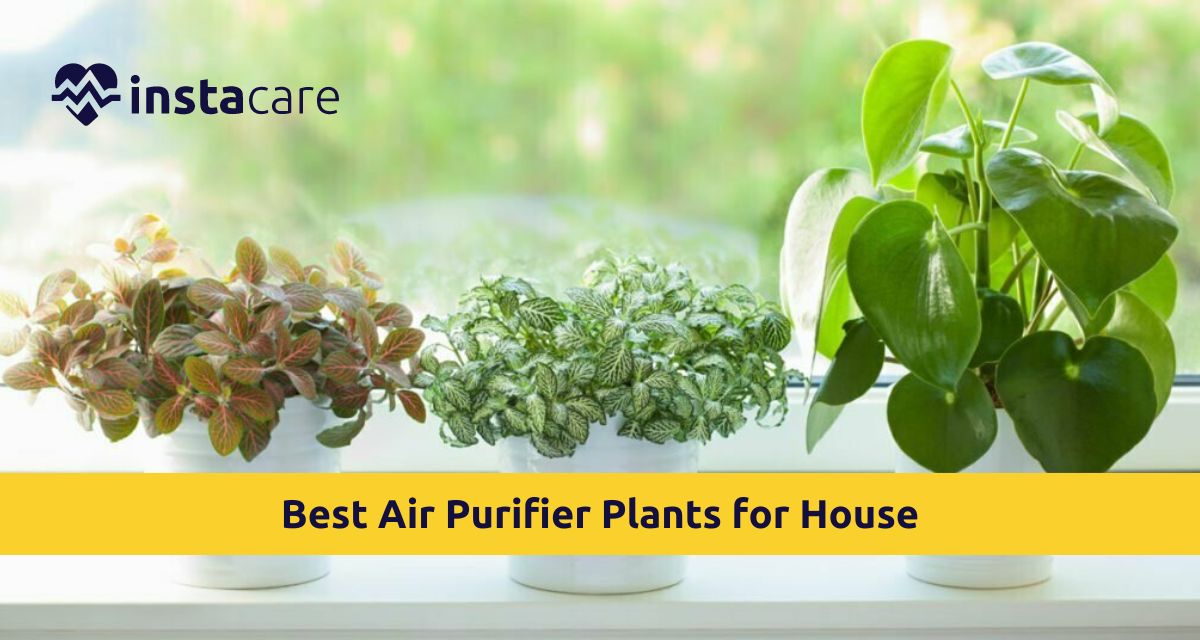Houseplants are never just decorations inside one's home. They serve a purpose, and that is their function to purify the air inside the housekeeping so every resident is safe in their journey toward healthy living. They say these plants are overgrowth in a household and might come to filter out the pollutants from the air to create a clean and fresh ambiance. The same being, the paper goes along with the top 20 houseplants famous for their air-purifying quality, giving associated benefits, care, and how to make your indoor look spectacular.
Here we discuss about top 20 houseplants famous for their air-purifying quality.!
1. Spider Plant
An air-purifying plant, this kind is named a spider plant because of its long, spidery shoot. Very easy to take care of, it mainly helps reduce volatile chemicals such as in the air such as formaldehyde and xylene. This plant will do well under any sort of lighting but strongly insists on being in surroundings with indirect light conditions. Being a very fast grower, it produces "babies" or offshoots and is quite popular, grown in hanging baskets or decorative pots. They need moderate watering and could live with weekly care; maybe that is why they are so well adapted to busy households.
2. Snake Plant
Many consider this plant as the classic mother-in-law's tongue, no doubt one of the best filters of formaldehyde, xylene, toluene, and benzene. Its pointed and narrow leaves are erect and will give every corner of your space a modern feel. Snake plants do pretty well with dim light and periods of watering followed by drying out—a no-fuss start to be an urban jungle enthusiast. Besides themselves, they are capable of releasing oxygen at night, providing improved air quality when one is asleep.
3. Peace Lily
This is a widely demanded plant for most situations. It bears nice white blooms and is well able to take away ammonia, benzene, formaldehyde, and trichloroethylene from the air. It likes growing under low to medium light and is happy with moist soil at all times. The peace lily has been an indoor cleaner, adding a class and elegance impression to homes. It does very well with proper watering and misting to maintain fantastic looks.
4. Boston Fern
Boston ferns are good 'finishers' of indoor air and do very well in high humidity and low light conditions characteristic of bathrooms and kitchens, where the level of moisture is high. Their feathery, lavish look makes them an attractive addition to a hanging basket or as part of the larger interior garden. They require copious humidity and watering.
5. Aloe Vera
Aloe Vera is popular as a soothing gel in the world of skin, but it makes the air pure. It removes formaldehyde and benzene from the air and needs very little maintenance. It grows well in bright, indirect light and requires very little watering because the thick, fleshy leaves hold enough water; therefore, this air-purifying plant can withstand drought. It is suitable for people who would easily forget their watering schedules.
6. English Ivy
This plant is one of the most versatile and powerful in removing airborne mold and toxins, such as formaldehyde and benzene. It adorns countless pieces of the interior, most commonly either as a hanging or climbing vine. It requires moderate to bright light and is generally watered thoroughly. However, it can be toxic to pets if they consume it.
7. Rubber Plant
Of course, these are all great ways of eliminating formaldehyde, yet the rubber plant can become a huge indoor tree, making quite a statement in appearance. Its place fits in with beauty in any room. Of course, it would want bright, indirect light, and its watering regularly enough. Its leaves are quite large and exceptionally glossy in the indoor rubber plant, striking to the eyes, and doing so very much to improve the quality of air. It needs some pruning for the sake of its shape, but it is relatively low maintenance in general.
8. Bamboo Palm
The bamboo palm purifies benzene, formaldehyde, and trichloroethylene. Their feathery fronds will be moistened make a habitat seem tropical and do well with indirect sunlight. The bamboo palms will also increase the level of humidity, which is good for the plant and in an indoor environment. They are easy to maintain, as they only require regular watering and occasional misting.
9. Pothos
The devil's ivy, another name for pothos, is a rugged, flexible plant known mostly for its winning performance in removing formaldehyde, benzene, and xylene. Trailing vines have made it that pothos is amongst the most common indoor decor drapers in hanging baskets and shelves. With mining windowsills and occasional watering, it's pretty easy to care for. Easy in care and quite adaptable, it's one of the best options for the rookie in indoor gardening.
View More: How To Manifest Good Health Through Mindful Practices
10. Chinese Evergreen
These are evergreen plants and, thus, have very attractive leaves. They are capable of purifying formaldehyde and benzene from the air and can adapt well to low to moderate light. They also require little care, occasional watering, and low light. The leaves, too, come with colors that may, therefore, decorate any space.
11. Dracaena
Dracaena plants are also commercially available in various types and are also good for removing unearthly toxins like those in formaldehyde, benzene, and trichloroethylene. They can be cultivated to a stunning indoor tree and are best placed in bright indirect light. Dracaenas require moderate watering and should occasionally be misted. They have an architectural aspect and the ability to house better air.
12. Gerbera Daisy
Colorful gerbera daisies are benzene and trichloroethylene-removing plants. Ever-flowering plants, the gerbera daisy prefers bright light and soil that is always just moist. In fact, inside the interiors of many a room, gerbera daisies add a flower-filled, florist shop-type renewal while cleaning the air. They do require a bit more maintenance than other decorative interior plants, but it is well worth it.
13. Philodendron
Philodendrons are some of the versatile plants that remove formaldehyde efficiently. Heart-shaped leaves make them elegant for in-room beautification. They do best in low to medium light. They need watering to allow their soil to stay moist but are pretty easy to take care of in most areas indoors.
14. ZZ Plant
This ZZ Plant boasts its toughness, growing well even under low light and dry conditions. It filters pollutants efficiently, such as xylene, toluene, and benzene. The ZZ Plant has very shiny, dark green leaves that provide that glossy and modern look for any interior. They need very little care, which includes watering occasionally. They are easy to handle.
15. Corn Plant
The corn plant is perfectly able to clean efficiently the said contaminants, such as formaldehyde, benzene, and trichloroethylene. They get tall, so in that inherent nature, they are also high on interior decoration oomph. Corn plants like bright indirect light and need to be watered at regular intervals. It has broad arching leaves that give any home a tropical feel as it works its magic on your air.
16. Areca Palm
They work well for filtering formaldehyde and benzene, but most importantly, they will add to the humidity of your home. They have a feathery look, with arched fronds that make the environment feel tropical. Areca palms require bright, indirect light and will need regular watering. Of course, that humidity-producing characteristic makes them most beneficial for dry indoor air.
17. Cast Iron Plant
This iron-cast plant gets its name from its toughness and
resistance to many different interior environments. The iron-cast plant removes
formaldehyde, tolerates low light, and forgiving if owners forget to water it.
It has oval, dark green leaves that bring in a full, striking effect when it is
grown indoors. The hardy nature makes it suitable for less experienced plant
owners.
The Parlor Palm is a most beautiful addition that rids one's residence of formaldehyde. It requires very slight light and is low-maintenance, fitting in very well with any small office or place. Periodic misting and regular watering maintain a Parlor Palm at its spectacular best.
19. Money Plant
Of course, the coin-shaped leaves of this plant make it convenient for just about anyone else to learn how not to resist adoring it, given that it purifies the air by taking off formaldehyde. This makes it very easy to grow and maintain, thriving well with bright but indirect light. Grossly adored by many indoor gardeners because of its singularity in its appearance and low care, the money plant should be just a plant you will love.
20. Hoya
Hoya, being a wax plant, clears formaldehyde. It has elegant traits due to its leathery leaf and sweet fragrant flowers. It thrives mostly in indirect bright light and low watering. The flowers of this hoya are beautiful, and the air purification makes for a great combination for indoor plants.
Conclusion
Houseplants will improve the quality of the air and enhance the beauty of the living space. Of the 20 houseplants described, all have different properties in cleansing the air and different needs in care; therefore, there is always something for the home. From the easily cared-for Sansevieria to the flashy Gerbera Daisy, there is a houseplant for all of your indoor spaces. By choosing the right plants and properly taking care of them, you can add to your interior both the aesthetic and health benefits of growing plants indoors.

